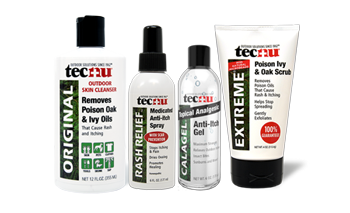
This blog is published in partnership with Tecnu, photo courtesy @tecnu_outdoor
While hiking, it is highly possible that you will encounter some plants that may or may not be poisonous.
You’ve probably heard the expression “leaves of three, let them be,” right? Well, there’s one big reason to leave them be: they’re poisonous.
Poison ivy (the plant that dubbed the infamous expression), poison oak, and poison sumac are wild plants found outdoors, and all of them share the same characteristic: they produce a skin irritant called urushiol.
Urushiol is a potent oil that causes an allergic reaction when you come into contact with it. Many describe the reaction as itchy, painful, and some even experience a burning sensation.
While an encounter with poison ivy, oak, or sumac is not deadly, it can be incredibly uncomfortable. Luckily, there are ways you can quickly treat an allergic reaction to alleviate symptoms.
While there is a chance you will encounter these plants while hiking, it’s important to note that well-groomed trails are typically a safe place for you to hike without worrying about coming into contact with poisonous plants.
In the event that you do come into contact with one of these poisonous plants, we prepared a helpful blog to guide you through what to do if you are exposed.
Keep reading to learn:
- How to identify poisonous plants
- Tips for avoiding poison ivy, oak, and sumac
- Ways you might come into contact with them
- What happens & what to do if you are exposed
Before You Go Hiking: How To Identify Poison Ivy, Oak, and Sumac
The best way to steer clear of poisonous plants is to know exactly what they look like. Below we’ll help you identify poison ivy, oak, and sumac.
Poison Ivy“Leaves of three, let them be.”

- What it looks like: Poison ivy can appear as a vine, shrub, or covering the ground. “To identify poison ivy, look for almond shaped leaflets that occur in clusters of three. Leaves are green in the summer, red in the fall, and the berries are usually grayish-white.” -Tecnu
- Where it’s found: all around the United States, except Alaska, Hawaii, and California
“Leaves of three, let them be.”

- What it looks like: Similar to poison ivy, poison oak has leaves of three. Their shape differs in that it mimics that of an oak tree.
- Where it’s found: Poison oak presents itself in two varieties: Eastern Poison Oak (from Texas to Florida) and Western Poison Oak (Washington, Oregon, California, and Nevada). A resilient plant, poison oak lives in the sun and the shade, and you can often find it in douglas fir forests.

- What it looks like: Poison sumac masquerades as a shrub or small tree that can reach up to 20 feet tall. Unlike poison ivy and poison oak, sumac has more than three leaves. In fact, it can have anywhere from 5-13 leaves, and it’s always an odd number.
- Where it’s found: You are most likely to encounter poison sumac in wet, swampy areas in the eastern United States.
Do you know about these other poisonous plants?
Also keep a lookout for:
- Poodle-dog bush
- Nettles
- Ragweed
Now that you know what to look for, let’s talk tips for avoiding these pesky plants.
Top Tips for Avoiding Poison Ivy, Oak, and Sumac
- Know your area and what flora you might encounter.
- Never touch plants and then touch your mouth, nose, eyes or any open wounds.
- Keep in mind that even when plants are dormant, they can still cause a rash.
- Stay on the trail! This is the safest route, and it also follows Leave No Trace principles.
Even if you are cautious and aware, you may still come into contact with a poisonous plant. Read on to find out what to do if this happens to you.
How You Might Come Into Contact With Poison Ivy, Oak, or Sumac
Nature is wild, and for that reason, you can never be 100% sure you won’t stumble upon something poisonous. Below you’ll find the most common ways you might encounter a poisonous plant.
- You brushed up against it and got the oil on your clothes or shoes.
- You unknowingly walked through it, and it made contact with an exposed area of your body.
- You went hiking with your dog, and they got the oil on their fur.*
*Tecnu Original Outdoor Skin Cleanser is safe for humans and pets! You can even use it to combat skunk encounters.
What Happens & What To Do If You Are Exposed

While roughly 25% of the population won’t experience an allergic reaction to a poisonous plant, the majority of us will likely get a rash immediately.
If you are exposed to poison ivy, oak, or sumac and notice a reaction, it’s best to treat it right away. Urushiol spreads easily, so avoid touching other areas of your body.
Use a cleanser that is designed to eradicate stubborn urushiol. We love the new Tecnu Detox Wipes because you can use them on the go, and they're safe for pets. You can also use this universal cleanser to wipe up all of your hiking equipment (be sure to do so within eight hours of contact).
If you experience a severe allergic reaction, use the Tecnu Extreme Poison Ivy Scrub. To use this product, you'll need access to water, so we recommend having it in the shower (not in a bath).
Add Tecnu To Your 10 Essentials
If you've been in the 52 Hike Challenge community for a while, then you probably know how important hiking safety and preparedness is to us.
While you’re most likely to have an awesome hike with no setbacks, you should always prepare for the unexpected.
Stock up on products that treat poison oak, ivy, and sumac reactions. This way, you won’t have to scramble for them when you need them most.

We love Tecnu products because:
- They’re proud partners with Leave No Trace
- You can safely use them on your pets
- You can also use them on your hiking gear
- They’re an Oregon Top 100 Employer
With 40+ years of creating potions and lotions for itches and ouches endured on the trail, we consider them the "outdoor itch experts.”
Protect Yourself From Poisonous Plants - Get Tecnu Now
As part of our sponsorship with Tecnu, you will receive an exclusive 35% off discount code with the purchases of your 52 Hike Challenge finisher medal. Plus, select 52 Hike Challenge purchases will include a free sample of Tecnu!
Where to find Tecnu products:
- In-store: visit your local REI to find Tecnu products on their shelves
- Online: buy directly from the Tecnu website: https://www.teclabsinc.com/
- Social: support Tecnu by following them on Instagram now

photo courtesy @tecnu_outdoor
Learn More:
- Download the Tecnu plant identifier app: https://www.teclabsinc.com/tips-info/tecnu-poison-ivy-and-oak-app
- Watch Tecnu videos on poison ivy: https://www.teclabsinc.com/tips-info/poison-ivy-videos

@Michelle, thank you for pointing this out. Systemic poison ivy reactions are very serious, and we will plan on touching on this more in a future blog.
@Marionette, thank you for reading and happy hiking!
Thank you! Very informative. Adding this product to 10 essentials/med kit is a very good idea.
I was surprised you did not mention the danger of inhaling smoke from burning poison ivy etc This can be dangerous and even life threatening if you inhale smoke that may contain the oils